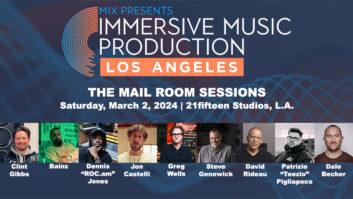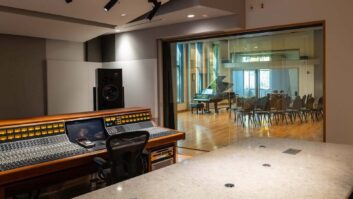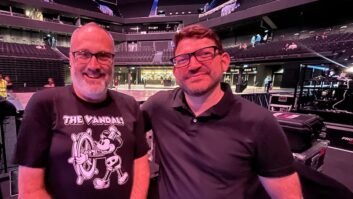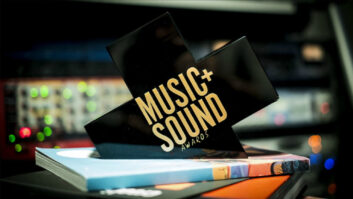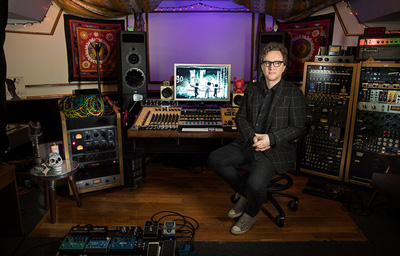
When Greg Wells walks into his Rocket Carousel Studio, ina cinder-block structure ona non- descript street next to an auto mechanic off of downtown Culver City, Calif., he is always ready to record. Seated at the custom Undertone Audio console in front of his PMC monitoring system, he can turn left to peer into the Drum Room, with mics in place around his 1941 Slingerland Radio King kit with 26-inch kick, drum heads on the wall,a second set at the ready, cables everywhere. To his right is the Piano Room, witha Steinway grand, Hammond B3, church basement upright, tack-aided saloon-style upright, and a melange of odd stringed instruments, guitars and amps. Vocal mics are always in place.
To his left, rhythm, to his right, melody. Even if it wasn’t consciously planned that way, the layout makesa lot of sense froma left-brain/right-brain or left-hand/right-hand perspective. Or, perhaps more telling: Drums were Wells’ first instrument; proficiency on piano led him to Los Angeles.
There is nothing fancy about Rocket Carousel, and there’s nothing fancy about Wells. The lobby is simple and spare, the hallways cluttered and tight, instruments are everywhere. Swirling murals and Eastern tapestries cover the walls. Vintage gear and vintage mics, a hybrid studio with an emphasis on the analog chain.
The ceilings are low, the vibe is warm. It’sa working musician’s laboratory and songwriter’s living room all at once, set up to encourage collaboration. And it sounds fantastic. People who come inwantto make music. Katy Perry has written and recorded there, Ryan Tedder, too. Rufus Wainwright. Keith Urban. So many others. Wells moved in 16 years ago, and it doesn’t look like he’s going anywhere soon.

It’sa long way from his arrival in L.A. in 1990, a 21-year-old minister’s son from Peterborough, Ontario, with a low-cost synthesizer, a Fostex 4-track,a bus pass and an apartment in Van Nuys.
He was simply a player then, he says, and honestly not aware whether he was any good.
“My entire career has felt likeI walked backwards into it,” Wells says today from his living room,a baby grand behind him anda wall of books in front. “I havea real attraction to things that are foreign to me.I feel more at home.A lot of people write what they know, what they grew up with.I have run from whatI knew, and I’ve run toward things thatI didn’t understand. Likea moth toa flame.”
The circuitous path from young, hot L.A. session player to songwriter, multi-instrumentalist, programmer, engineer, producer on more than 85 million records sold was not typical. The odds against Wells even making it to L.A., never mind working with the likes of Adele, Pink, Katy Perry, One Republic and on and on, were about equivalent to his making it in the NBA. It helped that he had serious musical talent; learning how to collaborate would open up his career.
Much of Wells’ childhood was spent in isolation, figuratively speaking, the realities of small-town Canada in the pre-cable, pre-Internet 1980s. His brain was wired for music, he had perfect pitch. He took piano lessons and taught himself drums and guitar. While other kids went to parties, he played music in his room. He joined every band in town, even sat in witha touring reggae act asa teen. He wasa bit awkward,a bit ofa nerd and loner. His best friend Derek was openly gay and into Andy Warhol and Laurie Anderson and John Waters. They sometimes got beat up together.
He hada good childhood, he says, no complaints. He was supported by parents, teachers and friends in his musical ambitions, but not really encouraged. Nobody helped to point the way. It was the times. All he knew was that he didn’t really belong, and he wanted to make records.
“I can remember this one moment whenI was about nine, riding in the station wagon on my way to skating lessons, andI was filled witha sense that I wasn’t in the right place.I didn’t know where to be, but something was not right,” he says. “I was insatiably curious about how to make great records, bea great musician.I would listen to Trevor Horn records. Grace Jones Slave to the RhythmI must have listened to 5,000 times. So musical, so full of surprises. How do you do that? It felt to me like the musicI listened to came from Mars, andI had no way to get to Mars.”
Humber College of Music in nearby Toronto, it turns out, provided the launchpad, anda few key people helped guide him out into the world. Kira Payne,a local sax player three years ahead of him, first told him he should
check it out. Brian Harris, with whom he studied during his senior year of high school, was head of the keyboard department and prodded him to audition. And professor Dave Stillwell, who becamea lifetime friend, was the leader of the smoking band that kept him in school.
“Nobody had mentioned that Humber at the time wasa hardcore bebop school,” Wells explains. “AndI didn’t knowa note of bebop or the standards. I got placed in an ensemble playing jazz standards and was not havinga good time.I thought I’d madea mistake. SoI went to Brian Harris and saidI was thinking of leaving. He gave mea room number fora new band, an ensemble, and said to go there the next morning, sayI sent you.
“It was like Earth, Wind& Fire and Tower of Power—horns, everything,” he continues. “I played keyboards. They were so good, mostly third-yearstudents.I had never played ina band like that before. Ensemble 2. Blue Jackets Required.I loved it.
Dave Stillwell was the teacher, and I’m still in touch with him weekly. He changed my life.I just played at his retirement party. The early stuff in our lives sticks with us. Humber gave me the awareness thatI could play on the team, speak the language.”
A formerstudent of Stillwell’s, Lou Pomanti—at that point and still the top studio keyboard player in Canada—came to an Ensemble2 performance, and Wells met him post-show. Later he would invite Wells to his home, and recommend him for jingle sessions around Toronto.

“Lou Pomanti is the guy who said, ‘Go to L.A. Do this! There’s something bigger for you,’” Wells says. “This was the first timeI had validation, and he lived inside the brass ring for every musician in Canada. He made me his understudy, and then pushed me out.”
After two years at Humber, Wells applied for and receiveda grant with the Canadian Council for the Arts to study piano for six months in Los Angeles with Clare Fischer, arranger for Prince, and Terry Trotter, master studio pianist and composer. He had not yet met them, and he didn’t knowa single person in town. These were the public transit days. The starving-with-no-money days.
“I would just show up at their houses, and there would bea piano in the living room,” Wells recalls. “I can remember my first lesson with Terry Trotter. He was showing somebody out, soI sat down and just started playing around, excited to be sitting ata grand piano! After about three minutes, he looks at me and says, ‘Why are you here?’I was confused. He said, ‘You should be playing. I don’t know what I’m going to teach you.’A renowned pianist telling me that I can swim in these currents… this stuff never happened to me. And Terry was a phenomenal teacher. He honed in on the detailed, finer points. ‘Lose some of the dorky stuff. Don’t be cute here.’ Tiny points and so spot-on. And he was a master in all genres.”
Wells’ talent soon became apparent, and Fischer and Trotter began recommending him for sessions all around town, mostly jingles but some records He met Lee Sklar ata session and they bonded over an impromptu jam on the third of Gershwin’s “Three Preludes.” Sklar also began recommending him for sessions. Wells meta lot of people, asked questions, and actively soaked up the knowledge, styles and techniques of master recording engineers and producers. He still considered himselfa player.
During these years of study and sessions, in his early 20s, Wells also played on three tours worldwide with kd lang, who calls him Multi to this day because he filled the role of three musicians, atopa riser with vibes, keyboard rigs, acoustic and electric guitars, odd percussion and accordion. For two of the tours he played drums. On one European tour, he subbed for Ben Mink and all his guitar parts, the many alternate tunings included.
“I learned so much from kd and Ben about getting out of the way and giving that amazing voice what it needs,” he says. “That was probably the first lesson in learning to bea producer, though I didn’t know it at the time.I was just soaking it up.”
Life was good. His musical chops were being recognized, he was meeting some heroes, he was in the room, playing with the best and learning everything he could from top engineers, arrangers, composers and producers. Then at age 25, he was invited by Miles Copeland toa relatively exclusive songwriting academy ata castle in France, and his world opened up.

“I didn’t consider myself a songwriterat all,” he explains. “The first timeI was there,I didn’t have that good ofa time.I was kind of shy, andI thought, ‘What amI doing here?’ ThenI got asked to go backa second time and said no. Everybody told me thatI was makinga huge mistake, soI went and had the time of my life.I met so many talented people.
“I metE from the Eels, Pete Shelley of the Buzzcocks, Carole King, Paul Brady,” he continues. “It was mind-blowing. Paul invited me to Ireland to hang out and write songs, andI went. It was watching masters of songwriting again and again and again. To be in the room with them. AndI found thatI brought music to the table.I learned thatI was pretty crappy by myself and didn’t really enjoy writing solo. ButI was welcomed into the room with Carole King or Mark Hudson and found thatI could bring their songs musically to life. IfI have any talent whatsoever, it’s being an accompanist. I’m only as good as whomever I’m working with.”
Songwriting begat production, and though Wells often inhabits both roles in some form or another, he doesn’t really distinguish between the two. He doesn’t engage in traditional pre-production. Once the sound or tone ofa song—a chord,a progression, sometimesa full melody—enters his head, it’s as if he’s already begun recording, mixing and mastering. It’s just the way his brain works, he says, adding, “When it’s all said and done, there’s no delineation to me between getting to know people overa dinner and mastering their record. “I talk about all this ina childlike way, butI do understand the minutiae and the detail. I’ma detail freak,” he laughs. “I’m Captain Geek Out Maximus.I can tell you the cabling we’re using, what the power supply is doing, how power is distributed.I make my own plug-ins, andI can’t live without my analog chain, so my studio is something ofa hybrid.I like thatI can insert my 1950s RCA compressor ona lead vocal and it shows up in Pro Tools as an analog insert. The centerpiece of the control room isa custom 32-fader UnderTone Audio console, designed by friend Eric Valentine, to go witha couple of MPEQ-1 outboard EQs. Nearly every audio source runs through one or the other at some point. He monitors through his beloved PMC MB2S-XBD monitors, and he uses his own Waves plug-ins every day. He is an accomplished recording and mix engineer; he still considers himself primarilya player.”
In 2006, his Humber mentor Dave Stillwell invited Wells back to his alma mater to address the student body in an all-day event, on stage. He was mortified, he said, thinking it would bea small group, not 350 people ina theater. After 15 minutes he began to ease into it, some of his father the minister came out, and he ended up enjoying himself. Ever since then he’s sought opportunities to teach, and to give back.
He funds music scholarships, runsa Twitter competition to give away free drum sets, teaches when invited, serves ona board fora nonprofit that provides reading glasses to schoolchildren, and is in the middle of producing an album, gratis, from inside San Quentin Prison. This year, in partnership with Hal Leonard Publishing, Pensado’s Place and their new Strive online curriculum, Wells will regularly share secrets from inside his studio.
“All I’m trying to do is be the person thatI wish had existed for me whenI was 20,” he says. “I want to share this informationI have, not hide it.”
So, at this point of the story, if you are expecting to find Katy Perry’s vocal chain or the compression setting on Adele, this isn’t that story. This is the story ofa boy from Canada who had music in his head and the dream of making records.
“My favorite qualities in art are being bold and brave witha sense of humor and an element of surprise,” Wells says in summation. “For my birthday parties asa kid,I can rememberI had the artsy gay kids and the tough jocks, the cool kids and the misfits. One year the coolest kid in the school was there. We never hung out, but there he was and it was fine. My discography looks like that birthday party. My friends look like that party. My life looks like that.”
